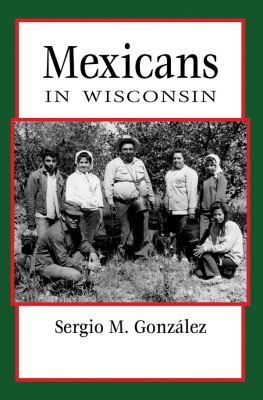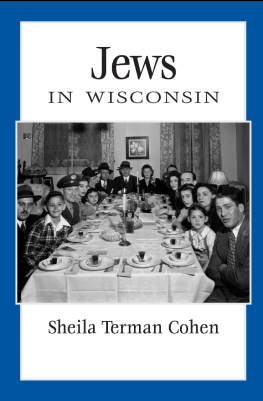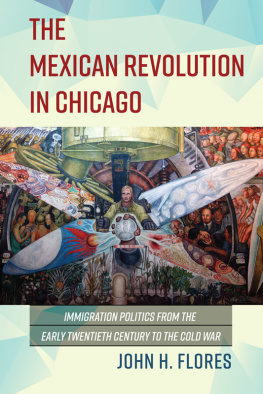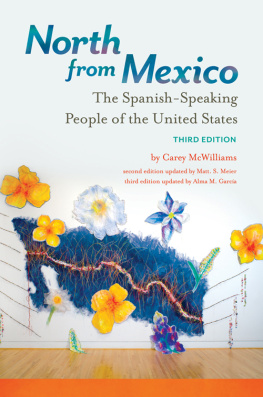Mexicans
IN WISCONSIN
Sergio M. Gonzlez
WISCONSIN HISTORICAL SOCIETY PRESS
Published by the Wisconsin Historical Society Press
Publishers since 1855
The Wisconsin Historical Society helps people connect to the past by collecting, preserving, and sharing stories. Founded in 1846, the Society is one of the nations finest historical institutions.
Join the Wisconsin Historical Society: wisconsinhistory.org/membership
2017 by the State Historical Society of Wisconsin
E-book edition 2017
For permission to reuse material from Mexicans in Wisconsin (ISBN 978-0-87020-834-8; e-book ISBN 978-0-87020-835-5), please access www.copyright.com or contact the Copyright Clearance Center, Inc. (CCC), 222 Rosewood Drive, Danvers, MA 01923, 978-750-8400. CCC is a not-for-profit organization that provides licenses and registration for a variety of users.
Photographs identified with WHi or WHS are from the Societys collections; address requests to reproduce these photos to the Visual Materials Archivist at the Wisconsin Historical Society, 816 State Street, Madison, WI 53706.
Front cover: A family of migrant cherry workers in Door County.
WHI IMAGE ID 18938
Back cover: Jesus Salas and Lupe Martinez are depicted in a section of a mural at First and Mitchell Streets in Milwaukee. The ten-by-eighty-five-foot mural completed in 2017 highlights the stories of migrant workers and Mexican American immigrants. It was created by lead artist Raoul Deal of the University of WisconsinMilwaukee Peck School of Arts, four undergraduate research assistants, and ten high school interns from Artworks for Milwaukee. Courtesy of Raoul Deal
Designed by Jane Tenenbaum
21 20 19 18 17 1 2 3 4 5
Library of Congress Cataloging-in-Publication Data Gonzlez, Sergio M., 1987author.
Mexicans in Wisconsin / Sergio M. Gonzlez.
1st edition. | Madison : Wisconsin Historical Society Press, [1987] |
LCCN 2017016088 (print) | LCCN 2017016660 (ebook) | ISBN 9780870208355 (Ebook) | ISBN 9780870208348 (pbk. : alk. paper)
Subjects: LCSH: MexicansWisconsinHistory20th century. | MexicansWisconsinSocial conditions. | MexicansWisconsinPolitics and government. | Migrant laborWisconsin.
LCC F395.M5 (ebook) | LCC F395.M5 G64 2017 (print) | DDC 305.868/720775dc23
LC record available at https://lccn.loc.gov/2017016088

To my parents, Bertha and Sergio Armando, who traveled different paths from Mexico to make Wisconsin our home. Their stories inspired this book.

Accomplished musician and composer Raphael Baez was the first known Mexican to settle in Wisconsin. He came to the United States with a touring company in 1884 and lived in Milwaukee from 1886 to his death in 1931.
Milwaukee County Historical Society
CONTENTS

WISCONSINS FIRST MEXICANO
A classically trained musician from a southern state in Mexico was perhaps the first Mexican ever to call Wisconsin home. Born in Puebla, Mexico, on May 15, 1863, Raphael Baez was the son of Jose de la Luz Baez, whose family had achieved minor fame in the region for its musical accomplishments. After the early death of Raphaels mother, Josefina, the elder Baez placed their five-year-old son in school, where he began his musical education. Even early in his studies, Raphael exhibited a remarkable ability to recognize and transpose complex compositions. At the age of fourteen, he completed his studies at the College of Arts and Industries with high marks in arithmetic and composition and began his career as a professional musician in Mexico City. There he served as the assistant organist at the Metropolitan Cathedral for two years and then as a violinist with the Grand National Theater orchestra.
Baez seized an opportunity to expand his vistas in 1884 through the C. D. Hess Grand Opera Company. One of the many touring opera companies of the late nineteenth century traveling extensively throughout North America, it began a countrywide tour of Mexico in the spring of 1884. Arriving in Mexico City, company directors met Baez, who had begun to make a name for himself as a talented musician and promising composer. Baez joined the company in a tour of the main cities of Mexico throughout the rest of their time in the country. C. D. Hess identified in Baez a certain talent and panache. He invited the young poblano (Puebla native) to the United States at the close of the Mexican season to continue as the companys chorus master.
After completing his tour with the Hess Company in 1866, Baez settled in Milwaukee, where he accepted the position of organist and musical director at Gesu Church, one of the citys most prominent congregations. Outside of the church, his first major musical appearance in the city came at the twenty-fourth annual Sengerfest of the North American Sengerbund, at the Milwaukee Exposition Building in July 1886. The weeklong festival featured eighty-five music societies with more than twenty-five hundred singers performing. Baez played violin for a ninety-nine-member orchestra under the direction of renowned composer Ernest Catenheusen.
Baez continued to enjoy a successful career in Milwaukee. He served in several different positions in the citys churches and synagogues from 1886 to 1925, including organist and musical director at the Church of the Holy Name, organist at Holy Rosary Church, guest organist at Temple BNe-Jeshrun and Temple Emanu-El, full-time organist and director at St.Johns Cathedral, and finally organist of St. Rose of Lima Church. Beyond his work as an organist and musical director, Baez also gained citywide prestige as a music teacher who stressed precision, punctuality, and practice. In 1887, Baez began teaching in his home, commencing a five-decade career that would make him one of the most sought-after music teachers in Milwaukee. The Milwaukee Journal referred to Baez as a splendid coach who, with even just a few musical lessons, was able to draw the proper perception of the music from his students. Baez taught piano, organ, and musical theory to students such as Hugo Goodwin, a concert organist who went on to become the organist and choir director of Chicagos St. Marks Episcopal Church and New England Congregational Church, and Charles Hambitzer, who later became the piano teacher and principal musical influence of George Gershwin. After Baez spent years conducting private music lessons for the children of Milwaukees elite, his acumen as an educator led him to a position as a music professor at Marquette College (now University) in 1892, making him the schools first Mexican faculty member. Baez also served as a language instructor for his university pupils, tutoring Marquette students in Spanish at his home.
Baez shared his dedication to music with his wife, Maria Catherine Schn, an accomplished vocalist and musician of German descent. The Baez duo, who were married on May 23, 1889, would often play together at musical performances, as they did for the Milwaukee Womens Club at the Athenaeum in 1904. They had four children, one of whom passed away as a baby. Raphael, the oldest son, served as an officer and squadron commander in the US Army Air Corps during World War II and later became a teacher in Bay View. His younger brother, Francis, served as an officer in the navy before returning to Milwaukee to work as a supervisor at Northwestern Mutual Life Insurance for more than thirty-five years. Their sister, Mary, also served her country on the home front at the navys Bureau of Yards and Docks, after which she went on to work as the first Mexican American employee at the Milwaukee County Courthouse.









